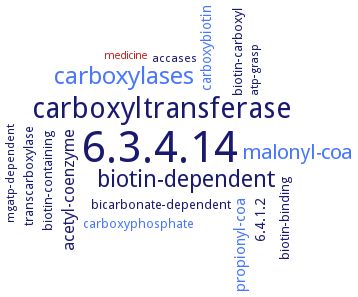6.3.4.14: biotin carboxylase
This is an abbreviated version!
For detailed information about biotin carboxylase, go to the full flat file.

Word Map on EC 6.3.4.14 
-
6.3.4.14
-
carboxyltransferase
-
carboxylases
-
biotin-dependent
-
malonyl-coa
-
acetyl-coenzyme
-
propionyl-coa
-
carboxybiotin
-
6.4.1.2
-
biotin-carboxyl
-
biotin-containing
-
bicarbonate-dependent
-
biotin-binding
-
carboxyphosphate
-
transcarboxylase
-
mgatp-dependent
-
accases
-
atp-grasp
-
medicine
- 6.3.4.14
- carboxyltransferase
- carboxylases
-
biotin-dependent
- malonyl-coa
-
acetyl-coenzyme
- propionyl-coa
- carboxybiotin
-
6.4.1.2
-
biotin-carboxyl
-
biotin-containing
-
bicarbonate-dependent
-
biotin-binding
- carboxyphosphate
- transcarboxylase
-
mgatp-dependent
- accases
-
atp-grasp
- medicine
Reaction
Synonyms
ACC, AccA, AccBC, AccC, BC, biotin carboxylase, biotin carboxylase (component of acetyl CoA carboxylase), biotinoyl domain of acetyl-CoA carboxylase, BirA, Carboxylase, biotin, More, PC-beta
ECTree
Advanced search results
Crystallization
Crystallization on EC 6.3.4.14 - biotin carboxylase
Please wait a moment until all data is loaded. This message will disappear when all data is loaded.
enzyme in complex with ATP analogues AMP-PNP and ADP-CF2P, hanging drop vapour diffusion, from 0.1 M Bis-Tris, pH 6.5, 0.2 M CaCl2, 45% methylpentanediol, and 10% ethylene glycol or 0.1 M KCl, 3-8% PEG 8000 and 20% ethylene glycol, respectively, X-ray diffraction structure determination and analysis at 2.05 and 2.69 A resolution, respectively, structure modelling
-
in absence and presence of ATP. Upon ATP binding, the central B-domain closes. Residues G165 and G166 play a role in ATP binding
-
in complex with biotinylated biotin carboxyl carrier protein, sitting drop vapor diffusion method, using 0.2 M ammonium sulfate, 0.1 M Bis-Tris (pH 6.5), and 25% (w/v) PEG 3350
in complex with inhibitors 6-(2,6-dibromophenyl)pyrido[2,3-d]pyrimidine-2,7-diamine and 6-(2,6-methoxyphenyl)pyrido[2,3-d]pyrimidine-2,7-diamine
sitting drop vapor diffusion method, using 17% (w/v) PEG3350 and 0.14 M CaCl2, (in complex with two ADP and two Ca2+ ions), or 0.1 M Bis-tris (pH 6.2), 15% (w/v) PEG3350, 0.1 M NH4Cl, and 5% (w/v) n-octyl-beta-D-glucoside (in complex with two ADP and one Mg2+ ion), or 18% (w/v) PEG3350, 0.17 M CsCl, and 4% (v/v) methanol (R16E mutant in complex with bicarbonate and Mg2+-ADP)
sitting-drop vapor diffusion method, crystallization of mutant enzyme E23R and F363A
wild-type Escherichia coli biotin carboxylase and mutant E296A in complex with its substrates biotin, bicarbonate, and Mg-ADP, at 2.0 A resolution. Residue Glu296 is the general base that extracts the proton from bicarbonate, and Arg338 is the residue that stabilizes the enolate biotin intermediate in the carboxylation reaction. The B domain of biotin carboxylase is positioned closer to the active site, leading to a 2-A shift in the bound position of the adenine nucleotide and bringing it near the bicarbonate for catalysis. One of the oxygenatoms of bicarbonate is located in the correct position to initiate the nucleophilic attack on ATP to form the carboxyphosphate intermediate. The phosphate group, derived from decomposition of carboxyphosphate, is the general base that extracts the proton on this N1 atom
the biotin carboxylase domain of pyruvate carboxylase from Bacillus thermodenitrificans is crystallized in an orthorhombic form (space group P2(1)2(1)2(1)), with unit-cell parameters a = 79.6 A, b = 116.0 A, c = 115.7 A by hanging-drop vapour-diffusion method. Two biotin carboxylase protomers are contained in the asymmetric unit. Diffraction data are collected at -173°C and the crystal structure is solved by the molecular-replacement method and refined against reflections in the 20.02.4 A resolution range
-
in complex with hydrogencarbonate, the ATP analogue AMP-PCP, phosphonoacetamide and phosphonoformate, ADP and phosphate and the carboxybiotin analogue N1'-methoxycarbonyl biotin methyl ester. Hydrogencarbonate, phosphate, and the methyl ester of the carboxyl group of N1'-methoxycarbonyl biotin methyl ester all bind in the same pocket in the active site of biotin carboxylase
crystal structures of the biotin carboxylase domain of human acetyl-CoA carboxylase ACC2 phosphorylated by AMP-activated protein kinase AMPK. The phosphorylated Ser222 binds to the putative dimer interface of biotin carboxylase, disrupting polymerization and providing the molecular mechanism of inactivation by AMPK. The structure of the biotin carboxylase domain in complex with soraphen A, a macrocyclic polyketide natural product, shows that the compound binds to the binding site of phosphorylated Ser222, implying that its inhibition mechanism is the same as that of phosphorylation by AMPK
recombinant apoenzyme or enzyme in complex with ATP analogue AMP-PCP, sitting drop vapour diffusion, from 0.1 M HEPES, pH 7.0, 0.2 M MgCl2, 15-20% PEG 3350, and 10% ethylene glycol in the well solution, X-ray diffraction structure determination and analysis at 2.4 A resolution, structure modelling
-
crystal structure of the recombinant biotin carboxylase domain alone and in complex with soraphen A, sitting drop vapor diffusion method, crystals belong to space group P2(1), with cell parameters of a = 63.83 A, b = 96.52 A, c = 139.95 A and beta = 96.82 A
in complex with acetyl-CoA. Acetyl-CoA promotes a conformation for the dimer of the biotin carboxylase domain of pyruvate carboxylase that might be catalytically more competent
recombinant enzyme in complex with ATP analogue AMP-PNP, sitting drop vapour diffusion, from 0.2 M KCl, 20% PEG 3350, and 20% ethylene glycol in the well solution, X-ray diffraction structure determination and analysis at 2.10, structure modelling
-


 results (
results ( results (
results ( top
top





